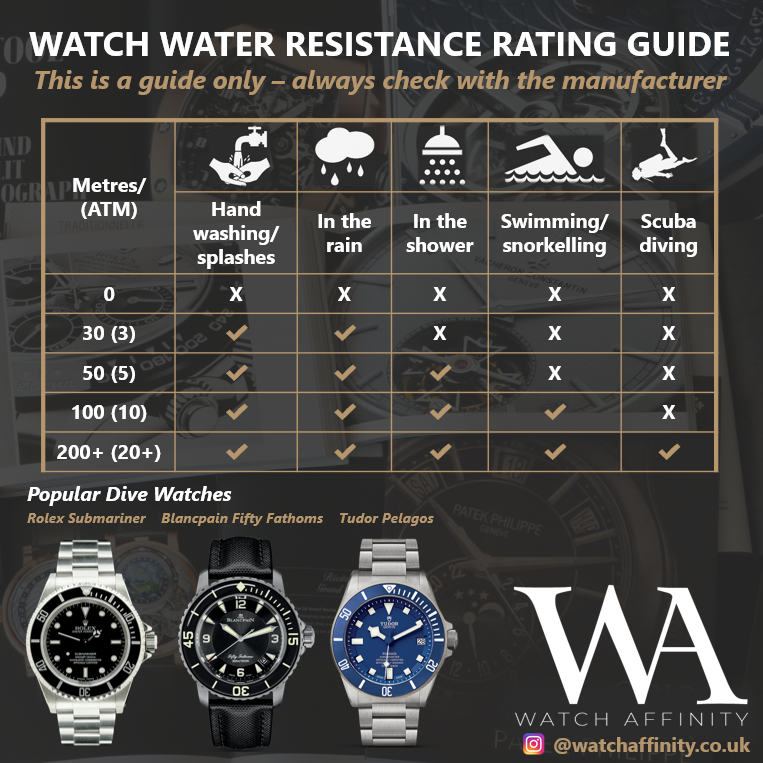A guide to watch water resistance ratings
Whilst recently catching up with a friend, he mentioned a problem he kept having with a fitness watch. This problem was that after he wore it swimming, more often than not, it would break, and he was on his third or fourth one. He couldn’t understand why, given this particular piece had a water resistance rating to 30 metres. He was surprised when I explained to him that 30 metres water resistance didn’t mean that the piece will work at 30 metres underwater.
Objectively, it is not unreasonable to assume that if a watch claims that it is water resistant to 30 meters, or 3ATM, that it is one which could be worn up to 30 metres underwater. It is somewhat surprising for most people to learn this, and I am sure that this misconception will have led to the demise of many a timepiece over the years.
Water resistance ratings for watches are often presented in either metres, or ‘ATM’ meaning atmosphere. This is also sometimes referred to as ‘BAR’. What this rating is indicating is the static pressure that the watch can withstand.
For example, let’s take a watch with a water resistance rating of 30 metres. This does not mean that the watch can be worn to underwater depths of 30 metres. This depth is the equivalent of 3ATM, or 3 BAR, and means only that the watch is resistant to three times the static atmospheric pressure at sea level.
As the atmospheric pressure increases, there are particular points of a watch that can become prone to failing such as gasket seals (“O” rings made from rubber, nylon, or other materials), the crown, or even the caseback itself. Should any of these parts fail, and allow water to enter the inner workings of the watch, then this can cause irreparable damage.
There are some mitigating features that can be incorporated into watches to defend these points, such as the gasket materials used, a screw down crown or a crown protector (both of which should always remain locked when coming into contact with water), and the screw-down caseback option as opposed to sapphire crystal.
There are environmental factors which can further effect the performance of these, such as the age of a watch and corresponding wear-and-tear, the temperature of the water and any chemicals present (such as chlorine), or even just a rapid change in pressure from diving or jumping into a pool.
We have prepared a guide below which helps to roughly translate these ratings into real-world scenarios:

Watch Water Resistance Ratings
Reminder: this is a guide only, and you should always check with your manufacturer.
In order to achieve these ratings, there are two types of testing that can be completed by a manufacturer: dry testing, and wet testing.
Dry testing is the safest, and entails subjecting the watch to increased pressures in a chamber, and the machine will measure even the tiniest variations in case size or air pressure. If the machine detects any change before the expected rating is achieved, then the watch will be judged to have failed the test. Because dry testing does not introduce water, the movement can remain in the case.
Wet testing introduces water to the equation, and consequently is undertaken on a pressurised case with no movement, such that in the event of failure it is not damaged. The case is pressurised to further than its rating, and submerged into water where it can remain submerged for minutes or hours – depending on the test. Once removed, it can be de-pressurised and then heated. As it cools, should any condensation appear inside the case on the crystal, the case will have failed the test.
A follow-up wet test to identify any issues is to suspend the case in a chamber filled half with air and half with water, above the surface of the water and increase the air pressure. Once the desired pressure is achieved, submerge the case and slowly release the air pressure. This will invite any air in the case to escape as small bubbles, and pin-points the failure.
Professionally rated diving watches are subject to ISO 6425, the International Standard for diving watches. This standard mandates the tests a watch must pass to meet the corresponding depth ratings. However, to throw a spanner in the works, not all watches marketed as diving watches will have been subjected to these specific tests, and some watches will not be marketed as diving watches but have passed the tests anyway.
Professional diving watches might also include further mitigating features such as a helium escape valve; these allow the small particles of helium within a watch case to escape without causing damage. As a diver surfaces, if there is a build up of helium in the case, then as the pressure on the watch eases during the surfacing, these particles can also cause irreparable damage.
Finally, we thought it would be interesting to share that in May 2019, Omega broke the world record for the deepest dive with a staggering 10,928 metres, or 35,853 feet in the Marianas Trench – this is deeper than the heights that some airliners fly at! You can read more about this feat on Omega’s website here.
Ultimately, the best advice we can offer is to always be aware of your watch’s rating, and avoid exposing it to water altogether. If you choose to do so, always check with your manufacturer first.
We hope you find this guide useful!
For any questions, please get in touch via our Contact page, or via our Instagram.
You might also be interested in:
As an Amazon Associate, I earn from qualifying purchases – thank you for your support

